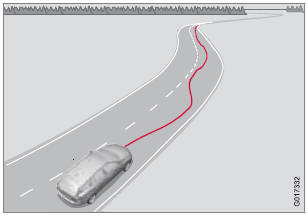Driver Alert Control (DAC)– introduction


This function is intended to alert the driver if his/her driving becomes erratic, such as if the driver is distracted or fatigued.
![]() NOTE
NOTE
The camera has certain limitations, see page 160.
A camera monitors the painted lines marking the lane in which the vehicle is traveling and compares the direction of the road with the driver’s movements of the steering wheel. The driver is alerted if the vehicle does not follow the lane smoothly.
DAC is designed to help detect a slowly changing driving pattern. It is primarily intended to be used on main roads and is not meant for use in city traffic.
![]() WARNING
WARNING
- DAC is not intended to extend the duration of driving. Always plan breaks at regular intervals to help remain alert.
- In certain cases, fatigue may not affect the driver’s behavior. In situations of this type, no warning will be provided. Therefore, it is important to take breaks at regular intervals, regardless of whether or not DAC has given a warning.
Limitations
In certain situations, DAC may provide warnings even if the driver’s driving pattern has not become erratic.
- if the driver is testing the LDW function
- in strong crosswinds
- on grooved road surfaces.
See also:
Introduction
Volvo recommends the use of Volvo trailer
hitches that are specially designed for the vehicle.
NOTE
See page 353 for the maximum trailer and
tongue weights recommended by Volvo.
• Observe the l ...
Owner maintenance
Periodic maintenance requirements and intervals
are described in your vehicle's Warranty
and Service Records Information booklet.
The following points can be carried out
between the normally sch ...
Erasing HomeLink Buttons
To erase programming from the three Home-
Link buttons (individual buttons cannot be
erased but can be “reprogrammed” as outlined
below), follow the step noted:
1. Press and hold the two outer ...
